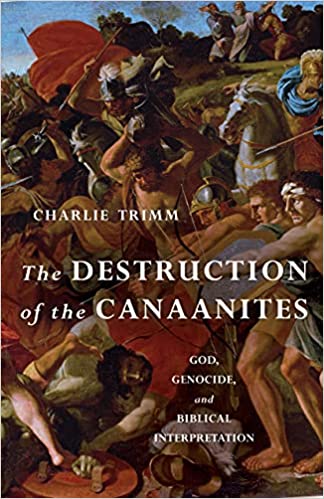A Book Review from Books At a Glance
by G. T. Tran
Summary of Content
In his book, The Destruction of the Canaanites, Charlie Trimm tackles the issue of divine violence in the Old Testament. Trimm explains his purpose of writing: “My goal in this book is not to tell you the ‘correct answer’ to the ethical problem of the destruction of the Canaanites. Instead, I want to help you see a fuller picture of the problem and walk with you through various proposed solutions, highlighting their strengths and weaknesses” (2, cf. 94).
The book is divided into two sections, the first dealing with three background issues (chaps. 1-3) while the latter presenting four possible answers to the Canaanite problem (chaps. 4-7).
In chapter 1, Trimm discusses warfare in the ancient Near East. He observes that countries in the ancient Near East engaged in war for several reasons, such as self-defense, establishing order, and taking plunder (7-8). Battles were fought either in open fields or by sieges (10-13). Further, the gods were seen as divine warriors and thus were actively sought out to ensure victories (17-19). The kings’ reports of the war’s outcome often employed hyperbole (19, cf. 24).
Chapter 2 deals with the history and definition of genocide (chap. 2). Trimm describes Raphaël Lemkin’s definition of genocide which includes actions aimed to destroy any national, ethnical, racial, or religious group (28). Further, Trimm contends that genocide was uncommon in the ancient Near East (31). The common cause for mass destruction was rather rebellion (33). As Trimm explains, nations in the ancient Near East “did not view ethnicity or religion as a group identity to be destroyed by genocide” (33).
Chapter 3 addresses the Canaanites’ identity. Not much is known about them outside of the Old Testament, but from the biblical record (e.g., Gen 10:6), they are Ham’s descendants (36-37). The book of Genesis shows mixed perspectives of the Canaanites (41). On the one hand, the patriarchs had positive relationships with them. On the other hand, there were also tensions. In addition, God’s commands regarding the Canaanites entail both expulsion and total destruction (41-46).
Subsequently, in the second part of the book, Trimm provides four possible responses to the Canaanite issue. For each response, he also offers some probing questions at the end.
The first response (chapter 4) is to reevaluate our conception of God, namely that he is not good. According to Trimm, this is not an option for Christians: “I emphatically reject the first approach that discards God and the Bible altogether” (94). The second response (chapter 5) is to argue that the violent texts in the Old Testament are not authoritative and that we should disassociate God from these texts (53). Chapter 6 presents the third response, which is to reevaluate our interpretation of the Old Testament. Advocates of this view argue that “the events in the Old Testament are not as violent as they appear” (65). In fact, they are not genocide at all (65). The last option, described, in chapter 7, is to reevaluate the ethics of violence in the Old Testament (77). This view accepts the veracity of the violence texts while maintaining that YHWH is just to punish the Canaanites.
Evaluation of Content
The book does three things well. First, Trimm succeeds in demonstrating the complexity of the issue regarding the Canaanites’ destruction (see esp. 41-46). Although some texts clearly mandate Israel to annihilate the Canaanites, other texts demand that the Canaanites be driven out. Moreover, the debated concept of herem further complicates the problem.
Second, the first chapter of the book provides helpful information about warfare in the ancient near East. For example, Trimm points out that it was not a standard practice in the ancient Near East to destroy one’s enemies completely (31). Further, the siege technique which forces civilians to retreat into the city explains why famine is the inevitable result. As Trimm describes, “During times of siege, surrounding villages were often emptied as the rural population fled to the cities” (12). Moreover, Trimm reminds readers that deities in the ancient Near East were viewed as divine warriors (17). Hence, it is no wonder that the Bible also portrays YHWH as a Divine Warrior.
Third, the book is well-researched. For each view, Trimm carefully interacts with its proponents and arguments. In fact, while the book’s content takes up 94 pages, 15 additional pages are bibliography. I must also add that his research is up to date.
Among these strengths, I maintain one critique regarding Trimm’s stance on the second response (ch. 5). As noted above, the second response (reevaluating the Old Testament) does not see the violent texts in the Old Testament as authoritative and insists that God be disassociated from these texts. Proponents of this view support their position in many ways, one of which is to argue that the violent events never took place (54-55). Even Trimm concedes that opting for this view “comes at the cost of being able to trust the Old Testament as a reliable document. [It] also usually entails a rejection of inerrancy (or at least a significant redefinition of the idea)” (64). Yet, unlike the first option which Trimm completely rules out (ch. 4), he appears sympathetic to this position, and nowhere does he reject it. In my opinion, the second response should have been ruled as an unacceptable option for Christians.
Overall, The Destruction of the Canaanites is a good introduction to the subject. The bibliography opens several avenues for further research should the reader desire. Thus, this book is a good primer to have as a resource.
G. T. Tran
